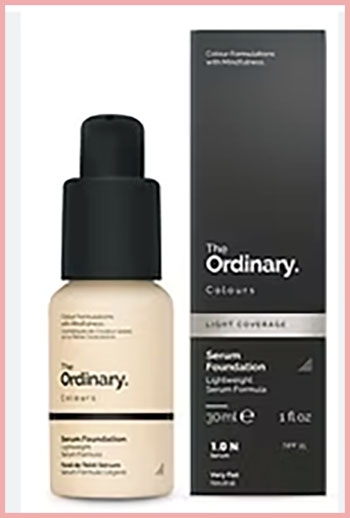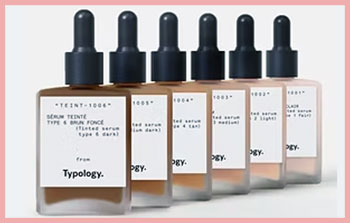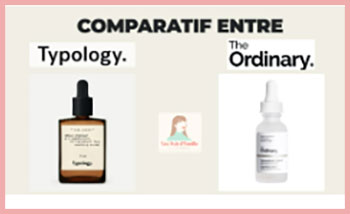I’ve spent years experimenting with skincare, chasing that elusive glow while navigating a maze of serums, moisturizers, and cleansers. When I stumbled upon Typology and The Ordinary, two brands that have taken the beauty world by storm, I knew I had to compare them. My goal? To unpack their minimalist approaches, ingredient-driven philosophies, and how they stack up for real users like you and me.
This article breaks down the pros, cons, and key features of both brands, using a semantic approach to explore their meanings and value in skincare. Let’s get started.
Comparison Table: Typology vs. The Ordinary
| Feature | Typology | The Ordinary |
| Origin | France, founded 2019 | Canada, founded 2016 |
| Philosophy | Minimalist, vegan, natural ingredients | Science-backed, minimal ingredients |
| Price Range | $10-$33 (15-30ml) | $6-$28 (15-30ml) |
| Key Products | Tinted Serum, Hyaluronic Acid Serum | Niacinamide Serum, Retinol Serum |
| Packaging | Sleek, apothecary-style dropper bottles | Clinical, utilitarian dropper bottles |
| Availability | Mostly online, select retailers | Widely available online and in stores |
| Certifications | B Corp certified, vegan, cruelty-free | Vegan, cruelty-free, no certifications |
| Target Audience | Eco-conscious, aesthetic-driven users | Budget-conscious, results-driven users |
| Ingredient Transparency | High, lists active percentages | High, lists active percentages |
| Customization | Skin diagnostic tool for tailored products | General product recommendations |
Understanding Typology: The French Minimalist
When I first discovered Typology, I was drawn to its chic, Parisian vibe. Launched in 2019 by Ning Li, Typology feels like the sophisticated cousin of minimalist skincare. The brand’s ethos revolves around clean, vegan, and natural ingredients, stripped down to the essentials.
I love how their products, like the 9-Ingredient Face Moisturizer or the Tinted Serum, prioritize simplicity without sacrificing efficacy. Their B Corp certification adds a layer of trust, signaling a commitment to sustainability and ethical practices. Plus, their Instagram-worthy packaging—think apothecary-style dropper bottles—makes my skincare routine feel like a ritual.
Typology’s approach is rooted in transparency. They list active ingredient percentages, so I know exactly what I’m putting on my skin. For example, their Hyaluronic Acid Serum combines high and low molecular weight hyaluronic acid for surface hydration and deeper moisture retention. It’s priced at around $33 for 30ml, which feels like a splurge compared to some competitors, but the quality justifies it.
Their skin diagnostic tool is a standout feature, guiding me to products tailored to my dry, sensitive skin. It’s like having a virtual dermatologist, which I appreciate as someone who’s easily overwhelmed by choice.
The Ordinary: The Science-Driven Disruptor

The Ordinary burst onto the scene in 2016 under Deciem’s umbrella, and I was hooked by its no-nonsense approach. This Canadian brand is all about delivering science-backed ingredients at jaw-droppingly low prices.
Their Niacinamide 10% + Zinc 1% Serum, a cult favorite, costs just $6 for 30ml.
I’ve used it to tackle congestion around my nose, and the results are noticeable—smoother texture, less redness.
The Ordinary’s packaging is clinical, almost medicinal, which suits its focus on function over flair. It’s not about looking pretty on my shelf; it’s about getting the job done.
What sets The Ordinary apart is its laser focus on single-ingredient or minimal-ingredient formulas.
Their Retinol 0.2% in Squalane, for instance, targets fine lines without overwhelming my skin. I like that they break down complex ingredients like retinoids or peptides into digestible terms, making skincare accessible even for beginners.
However, their vast product range can feel like a chemistry lab, and without a diagnostic tool, I sometimes second-guess my choices. Still, the affordability makes experimentation low-risk, which is a game-changer for budget-conscious users like me.
Pros of Typology
Let’s talk about what makes Typology shine. First, their commitment to natural and vegan ingredients resonates with me as someone who cares about what goes on my skin. The absence of phenoxyethanol, a controversial preservative, is a big win—especially since I’ve noticed my sensitive skin reacts to it in other products. Their Tinted Serum, with 99% natural ingredients and a 90/100 Yuka score, feels like a skincare-makeup hybrid that doesn’t clog my pores.
I also love the customization aspect; the skin diagnostic tool helped me pick products like the 10% Glycolic Acid Serum, which gently exfoliates without irritation.
Another pro is Typology’s eco-conscious ethos. Their B Corp status means they’re held to high environmental and social standards, which aligns with my values. The packaging, while not the most durable (more on that later), is recyclable and minimalist, reducing waste.
Their focus on specific skin concerns—like hormonal acne or dryness—makes their products versatile for users of all ages, from teens to those tackling mature skin issues. For me, Typology feels like a brand that cares about both my skin and the planet.
Cons of Typology

No brand is perfect, and Typology has its drawbacks. The price point is a sticking point for me.
At $33 for a 30ml Hyaluronic Acid Serum, it’s significantly pricier than similar products from other brands. While the quality feels worth it, my wallet doesn’t always agree, especially when I’m restocking multiple products.
The small bottle sizes—often 15ml or 30ml—mean I run out quickly, and I wish they offered larger options to offset the cost.
Availability is another issue. Typology is primarily sold online, which is convenient until you realize their shipping can be slow, especially outside Europe. I’ve waited weeks for orders, which tests my patience. Their zero return or refund policy also feels risky; if a product doesn’t work for me, I’m out of luck.
Lastly, while the packaging looks gorgeous, the glass droppers can be fragile. I’ve dropped one and watched it shatter, which was a frustrating $20 lesson.
Pros of The Ordinary
The Ordinary’s biggest strength is its affordability. I can grab a Niacinamide Serum for $6 or a Caffeine Solution for $7, making it easy to build a full routine without breaking the bank. This is a lifesaver for someone like me who loves trying new products but hates overspending. Their ingredient transparency is another win; they clearly list concentrations, like 10% Vitamin C in their Vitamin C Suspension, so I know exactly what I’m getting. This empowers me to make informed choices without needing a PhD in chemistry.
The brand’s wide availability is a huge plus. I can find The Ordinary at Sephora, Ulta, or online retailers like Amazon, making restocking a breeze. Their vegan and cruelty-free formulas also appeal to my ethical side, though they lack the B Corp certification Typology boasts.
The Ordinary’s focus on proven actives—like retinol, niacinamide, and hyaluronic acid—means I can trust their products to deliver results, whether I’m fighting acne or fine lines. For a 31-year-old like me, starting to notice aging signs, this reliability is everything.
Cons of The Ordinary
The Ordinary isn’t flawless, though. The sheer number of products can overwhelm me. With dozens of serums and acids, picking the right one feels like solving a puzzle. Their website offers guidance, but it’s not as personalized as Typology’s diagnostic tool.
I’ve also noticed some formulas, like the Vitamin C Suspension, can feel gritty or irritating on my sensitive skin, which makes me cautious about certain products.
Another downside is the inconsistency in ingredient minimalism. Their Hydrating Moisturizer, for example, has 46 ingredients, which feels at odds with their “less is more” mantra. I was disappointed to find phenoxyethanol in some products, given its potential toxicity concerns.
Lastly, the clinical packaging, while practical, lacks the aesthetic appeal of Typology’s bottles. For someone who enjoys a luxurious skincare experience, The Ordinary can feel a bit sterile. It’s a minor gripe, but it affects how I feel about my routine.
A Semantic Approach to Comparing Typology and The Ordinary
Using a semantic approach, I’m looking beyond surface-level features to understand the deeper meaning and context of these brands. Typology embodies a holistic, eco-conscious philosophy, appealing to users who value sustainability and aesthetics alongside efficacy. Their products, like the Organic Orange Blossom Hydrolat, evoke a sensory experience—think floral scents and elegant packaging—while delivering targeted results.
The Ordinary, on the other hand, prioritizes scientific precision and accessibility, catering to users who want proven actives without the frills. It’s about function over form, with a focus on democratizing skincare.
Semantically, Typology aligns with “clean beauty” and “sustainable luxury,” while The Ordinary represents “affordable science” and “functional minimalism.” These meanings shape their product offerings and user experiences.
For example, Typology’s Tinted Serum (25 ingredients) feels like a natural, lightweight makeup alternative, while The Ordinary’s version (34 ingredients) leans more toward coverage, with less natural components like cyclopentasiloxane. Understanding these differences helps me—and you—choose a brand that aligns with our values and skin needs.
Key Features Head-to-Head
Let’s break down some flagship products. Typology’s Tinted Serum, available in six shades, blends 99% natural ingredients for a dewy, barely-there finish. I love how it hydrates while evening my skin tone, perfect for my no-makeup days.
The Ordinary’s Tinted Serum, with 21 shades, offers better coverage but includes less natural ingredients, which might not suit sensitive skin like mine. Both are vegan and cruelty-free, but Typology’s higher Yuka score (90/100 vs. The Ordinary’s lower ratings) gives it an edge for clean beauty fans.
For hydration, Typology’s Hyaluronic Acid Serum uses two molecular weights for multi-level moisture, leaving my skin plump and soft. The Ordinary’s Hyaluronic Acid 2% + B5 is similar but more affordable at $7.
I’ve used both, and while Typology feels more luxurious, The Ordinary’s version is nearly as effective for half the price. For exfoliation, Typology’s 10% Glycolic Acid Serum is gentle yet effective, while The Ordinary’s Lactic Acid 10% + HA can feel harsher on my skin, though it’s a fraction of the cost.
Read More: Clarins vs. Kiehls
My Personal Experience: A Real User’s Take

As someone with dry, sensitive skin prone to redness, I’ve tested both brands extensively.
Typology’s 9-Ingredient Moisturizer became my go-to for its lightweight feel and lack of irritants. After a month, my skin felt softer, and the redness around my cheeks calmed.
However, the $25 price tag for 50ml stings when I compare it to The Ordinary’s Natural Moisturizing Factors + HA, which costs $6 and does a solid job, though it feels heavier.
The Ordinary’s Niacinamide Serum transformed my texture, reducing pores and breakouts within weeks. But when I tried their Vitamin C Suspension, the gritty texture irritated my skin, unlike Typology’s smoother Vitamin C Serum, which I could tolerate daily. Typology’s diagnostic tool was a game-changer, recommending products that matched my needs perfectly.
The Ordinary’s trial-and-error approach, while budget-friendly, left me guessing at times. If I had to choose, Typology’s curated experience wins for my sensitive skin, but The Ordinary’s affordability keeps me coming back.
Who Wins for You?
Choosing between Typology and The Ordinary depends on your priorities. If you value natural ingredients, sustainability, or a tailored approach, Typology’s your match. Its chic packaging and eco-conscious ethos make it feel like a treat, though you’ll pay more for it.
If budget and accessibility are key, The Ordinary delivers unmatched value and science-backed results, even if the experience feels less personalized. For me, it’s a tie—I mix and match, using Typology for serums and The Ordinary for basics like niacinamide.
Both brands redefine minimalist skincare, but they speak to different needs. Typology’s semantic identity is about mindful beauty; The Ordinary’s is about democratized efficacy. Ask yourself: Do you want a curated, eco-friendly routine, or a budget-friendly, results-driven one?
Your answer will guide you. Either way, you’re investing in brands that prioritize transparency and results, making your skincare journey—whether luxurious or practical—worth every drop.
Frequently Asked Questions (FAQ)
Typology is a strong contender, alongside brands like Good Molecules and The Inkey List, due to their shared focus on affordable, ingredient-driven skincare.
The Ordinary, Good Molecules, and The Inkey List are comparable for their minimalist, science-backed formulas, though Typology emphasizes natural ingredients more.
No, Typology isn’t medical grade, but its high-potency actives and transparent formulations make it effective for targeted skincare concerns.
There’s no confirmed evidence that Kim Kardashian uses The Ordinary, though she’s known to favor high-end skincare brands.
Also Read: BareMinerals vs. Beautycounter
Conclusion
You’ve seen how Typology and The Ordinary stack up, and I hope this breakdown helps you navigate your skincare choices. Typology’s eco-conscious, curated approach feels like a love letter to mindful beauty, while The Ordinary’s affordable, science-driven formulas empower you to experiment without breaking the bank.
Both brands deliver results, but their semantic identities—Typology’s sustainable luxury versus The Ordinary’s functional minimalism—cater to different needs. Pick what resonates with you, whether it’s Typology’s chic serums or The Ordinary’s budget heroes. Your skin deserves the best, and these brands make it easier to find what works.

im gonna get serums from topology a d the rest from the ordinary thankyou ✨️